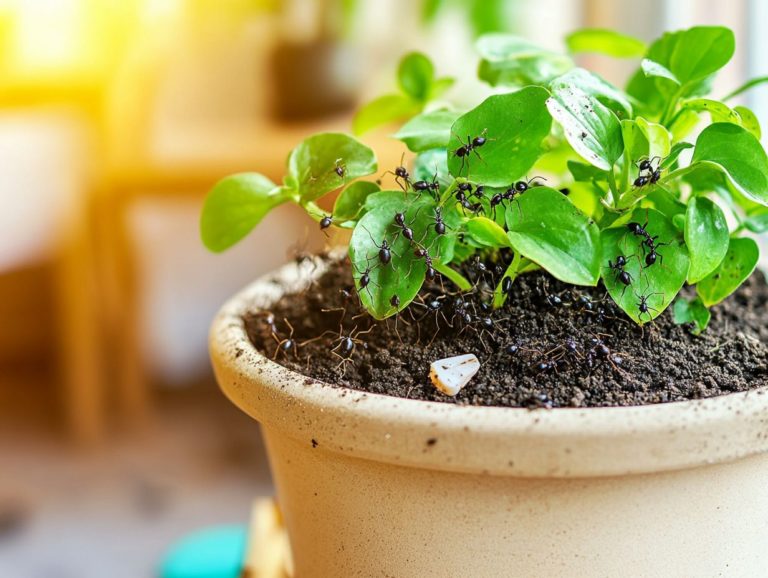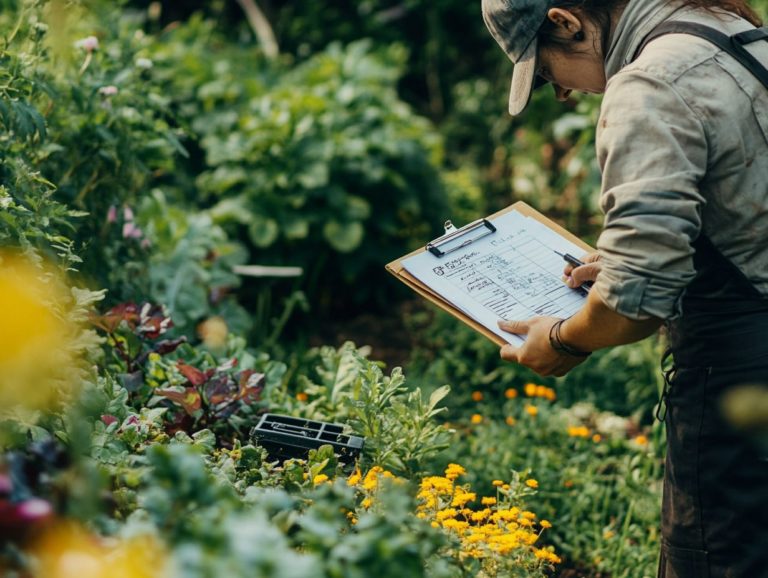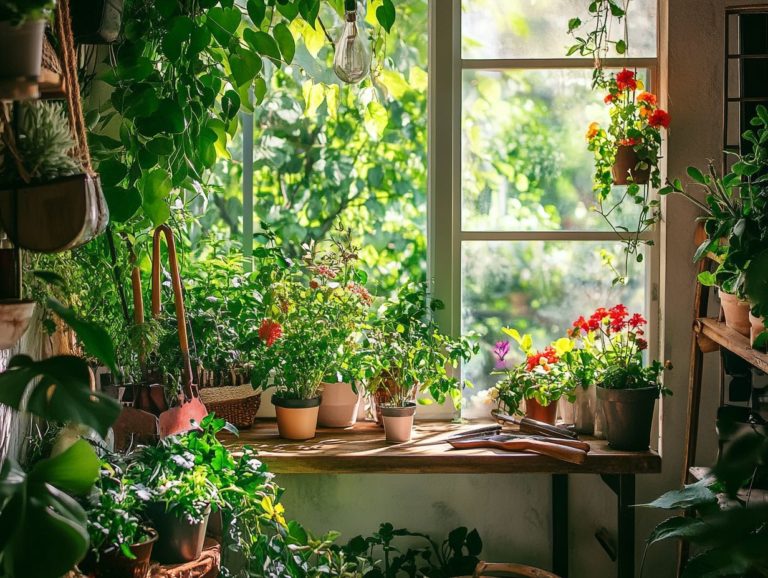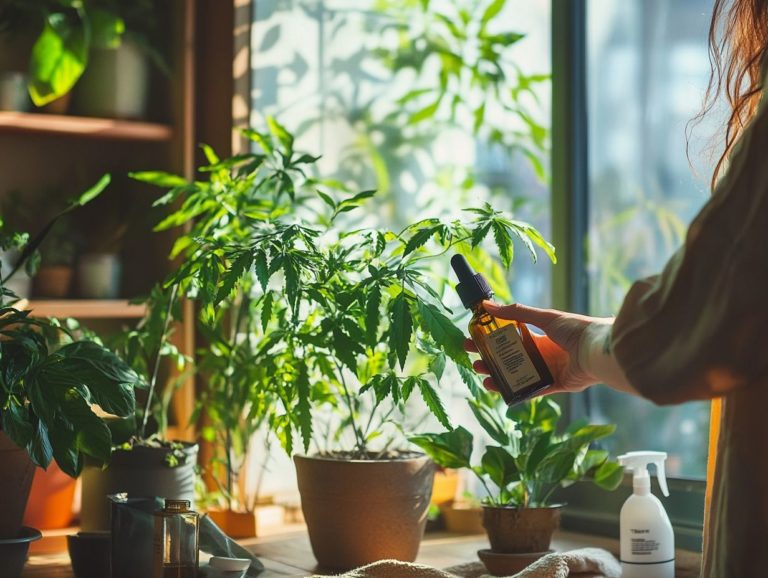Preventing Mealybugs in Houseplants
Mealybugs can cause serious harm to your houseplants, often slipping under the radar until the damage is done.
These tiny bugs not only harm your foliage but can also multiply rapidly, resulting in widespread infestations. It s essential to understand what mealybugs are, how they spread, and the unmistakable signs of an infestation.
You ll want to explore effective prevention strategies and natural remedies that can help keep them at bay. Knowing when it s time to summon the professionals is equally important.
By learning how to tackle these pesky invaders, you can ensure your indoor plants remain healthy and thriving.
Contents
- Key Takeaways:
- Understanding Mealybugs
- Signs of Mealybug Infestation
- Identifying Symptoms
- Preventing Mealybugs in Houseplants
- Best Practices for Plant Care
- Natural Remedies for Mealybug Control
- Non-Toxic Solutions
- Dealing with Severe Infestations
- Frequently Asked Questions
- What are mealybugs and how do they affect my houseplants?
- How do mealybugs spread and infest houseplants?
- How can I prevent mealybugs from infesting my houseplants?
- Are there any natural ways to prevent mealybugs in houseplants?
- What should I do if I notice mealybugs on my houseplants?
- How can I prevent mealybugs from coming back after treatment?
Key Takeaways:
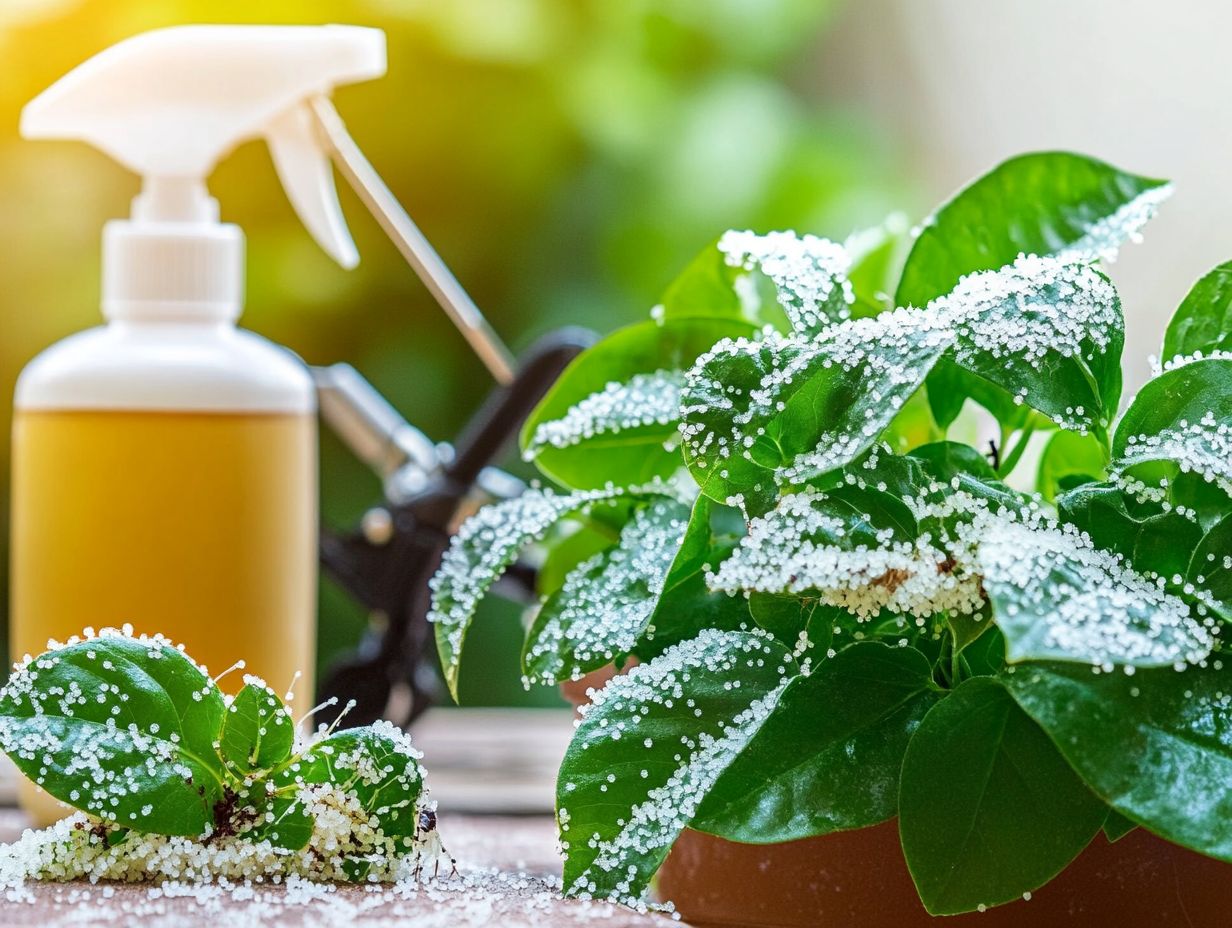
- Regularly inspect and clean houseplants to prevent mealybug infestations.
- Avoid overwatering and keep plants healthy to stop mealybugs from spreading.
- Use natural remedies such as neem oil or rubbing alcohol to control mealybug infestations without harmful chemicals.
Understanding Mealybugs
Understanding mealybugs is crucial for anyone serious about plant care. Protecting your indoor plants from these infamous pests is essential.
Mealybugs are tiny bugs that suck sap and can cause serious harm to your cherished houseplants through their feeding habits.
You ll often identify them by their white, fluffy appearance and the cottony deposits they leave behind, which are telltale signs of an infestation. By familiarizing yourself with their life cycle and behavior, you ll gain the power to take swift action and safeguard your plants from this prevalent issue.
What are Mealybugs?
Mealybugs are small, soft-bodied pests from the family Pseudococcidae, known for their sap-sucking habits. You ll often find these minute insects clustered on the undersides of leaves or along stems, clad in a white, waxy coating that provides some protection against their natural predators.
Their primary feeding method involves piercing plant tissues to extract sap, a practice that can weaken your beloved plants significantly. As they indulge in their feast, they excrete a sticky substance called honeydew. This sweet secretion not only attracts other pests but also creates a perfect breeding ground for sooty mold.
This black fungal growth can smother the leaves, obstructing photosynthesis and ultimately diminishing your plant’s vigor and overall health.
How do they Spread?
Mealybugs have a knack for spreading efficiently, primarily through contaminated gardening tools, infested plants, and the diligent movement of ants, who protect them in exchange for their sweet honeydew.
These pests can easily travel on your clothes or in contaminated potting soil. Once they set up shop, the mealybug population can multiply at an alarming rate, posing significant risks to your cherished plants.
Ants play a pivotal role in this unwelcome spread; by tending to them, they secure a steady supply of honeydew and assist in relocating mealybugs to other plants, spreading the infestation even further.
However, there s a silver lining. Ladybugs and lacewings can help eliminate these pests, providing a more eco-friendly solution to your pest control woes.
By fostering a balanced ecosystem in your garden, you can dramatically cut down mealybug numbers and, in turn, promote the vitality of your plants.
Signs of Mealybug Infestation
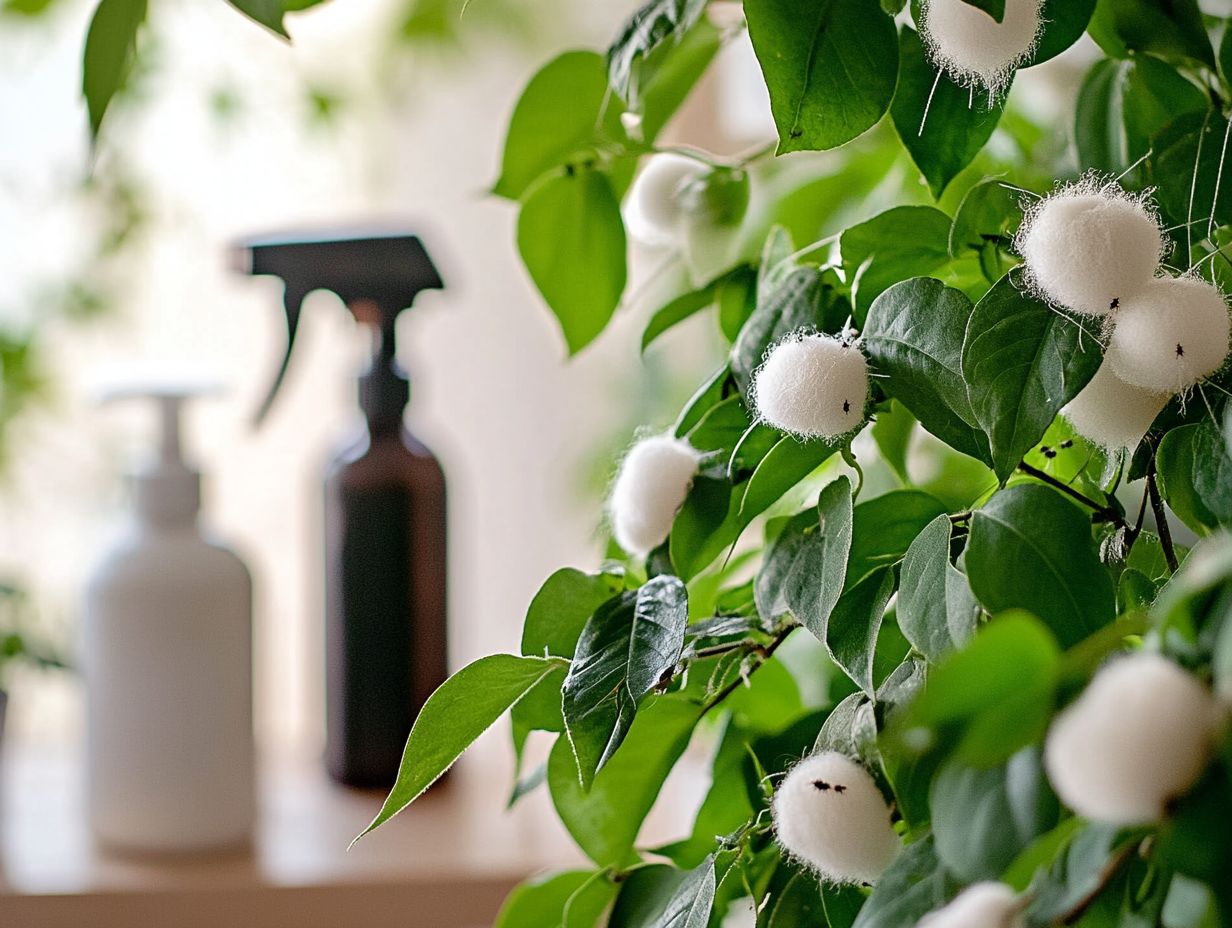
Identifying the signs of mealybug infestation is essential for preserving the health of your indoor plants and preventing considerable damage to your foliage. These pests can reproduce rapidly and take over your space if you’re not careful.
Look out for telltale symptoms such as cottony deposits on leaves, a sticky residue from honeydew, and the unsightly presence of sooty mold, all of which can compromise your plants’ well-being.
Regular inspections are vital don t wait until it s too late! Catching these indicators early allows you to implement effective control methods before the situation spirals out of control.
Identifying Symptoms
Identifying the symptoms of a mealybug infestation starts with looking for key indicators. Look for cottony deposits and sticky honeydew on your plants.
You may notice tiny white clumps, also known as cottony masses, appearing along plant stems and leaf axils. They’re easy to spot if you keep an eye out. The sticky honeydew, which is a sugary substance secreted by the mealybugs, can lead to sooty mold. This mold hinders your plants’ ability to photosynthesize effectively (the process plants use to make food from sunlight).
As the infestation worsens, affected plants may show signs of wilting, yellowing leaves, or stunted growth. These symptoms can severely impact their overall health. Understanding these signs in relation to the mealybug life cycle is crucial. When these pests reproduce rapidly, they can quickly overwhelm weakened plants, creating a cycle of decline that s tough to break.
Preventing Mealybugs in Houseplants
Preventing mealybugs in your houseplants is essential for any dedicated plant enthusiast. Adopting best practices in plant care can greatly minimize the risk of infestation.
Regularly inspecting your indoor plants is key for early detection. This enables timely interventions that can stop these pests in their tracks before they multiply.
Maintaining healthy plants helps prevent infestations. Encourage natural predators, and avoid over-fertilization. This creates an environment that s much less inviting to mealybugs. Embracing these preventive measures empowers you to maintain a thriving indoor garden.
Best Practices for Plant Care
Implementing best practices for plant care significantly helps in preventing mealybug infestations in your indoor plants.
Creating a nurturing environment involves a few essential steps:
- Regularly inspect leaves and stems. This not only aids in the early detection of mealybugs but also contributes to the overall health of your plants.
- Proper watering practices are crucial. Overwatering can create a damp environment where mealybugs flourish.
- Utilizing the right gardening tools, like pruning shears and insecticidal soap sprayers, makes maintenance easier.
- Ensuring adequate air circulation and light keeps your plants robust and less vulnerable to infestations.
By adopting these straightforward yet effective strategies, along with preventing pest infestations in indoor plants, you can protect your cherished greenery and foster a thriving indoor ecosystem.
Natural Remedies for Mealybug Control
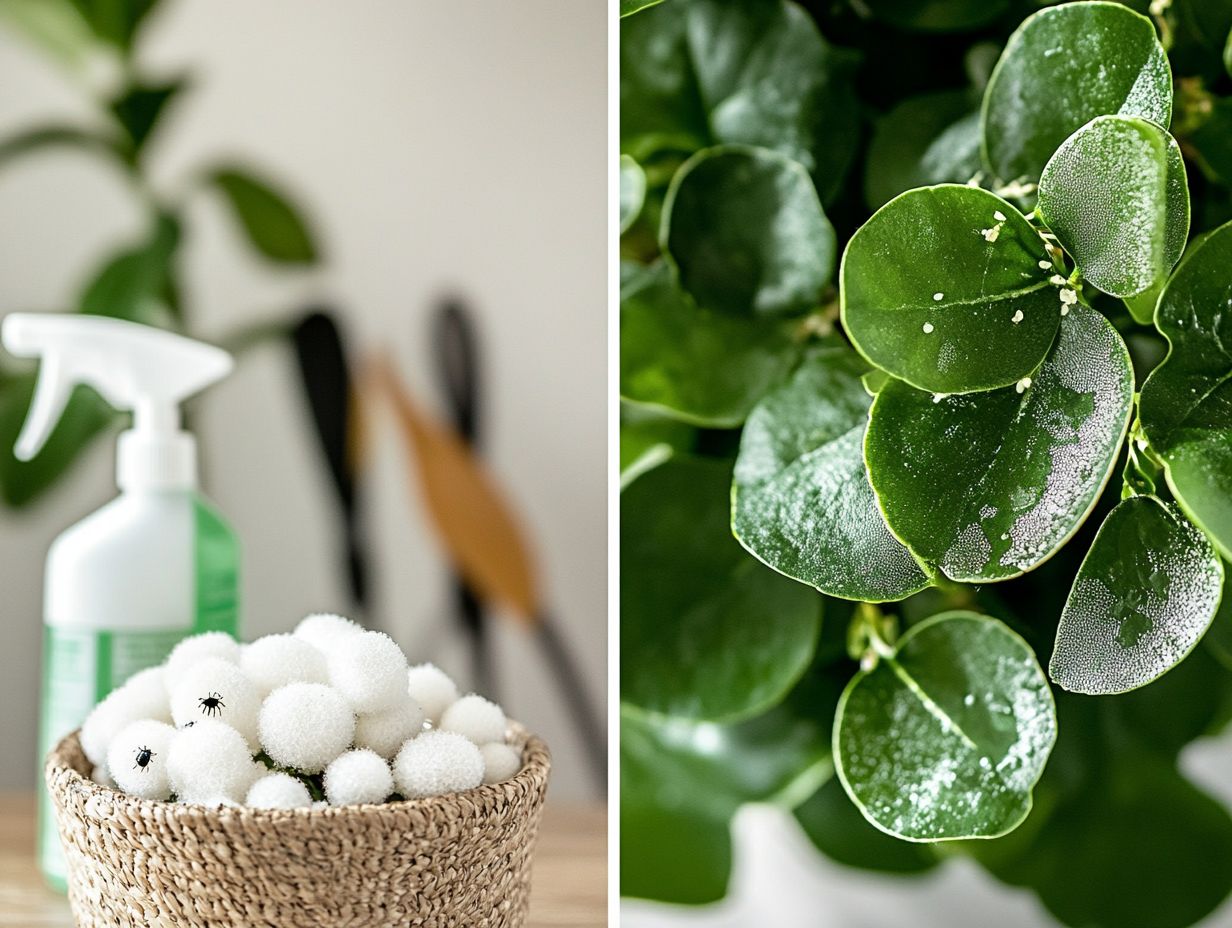
Natural remedies for mealybug control provide effective strategies for managing these pests without harsh chemicals. This ensures the well-being of your indoor plants.
By using solutions like neem oil and insecticidal soap, you can effectively eliminate mealybugs while being kind to the environment. These non-toxic options target the pests directly and reduce potential harm to beneficial insects, making them ideal for sustainable plant care practices.
Non-Toxic Solutions
Using non-toxic solutions like neem oil and insecticidal soap is an effective way to control mealybugs while keeping your indoor plants safe. These remedies not only protect the environment but also act as a powerful defense against those pesky pests.
Neem oil, derived from the seeds of the neem tree, disrupts the life cycle of mealybugs by interfering with the ways bugs grow and reproduce. This means it effectively prevents them from maturing and reproducing. In contrast, insecticidal soap works by suffocating the insects upon contact. It disrupts their cell membranes, leading to their demise.
Both options provide eco-friendly alternatives to harsh chemical pesticides. They minimize the risk of toxic residues that could negatively impact beneficial insects, pets, and your own health.
Dealing with Severe Infestations
When faced with a severe mealybug infestation, act quickly to protect your plants from further damage. This may involve seeking professional assistance or using manual removal techniques.
If you observe a noticeable spike in mealybug populations, respond promptly to mitigate their impact on your plants. While natural remedies can be effective for minor infestations, advanced cases may require a more assertive approach to eliminate the pests and restore your plants to their former glory.
When to Seek Professional Help
Knowing when to seek professional help for mealybug infestations can make all the difference in saving your indoor plants from significant damage and discovering effective eradication methods.
Recognizing the telltale signs of a severe mealybug problem is essential. These pests often manifest as small, white, cottony clusters on leaves, stems, or soil. Their sticky honeydew excrement can attract unwanted ants, potentially leading to sooty mold growth. Spotting large clusters means it’s time to take action!
If you notice a general decline in your plant’s health, it might be time to call in pest control services.
When they arrive, you can expect a thorough assessment of the infestation’s extent, identification of the mealybug species, and tailored recommendations for treatment methods. These might include targeted insecticides or biological control strategies.
To prepare, prune the severely affected areas and isolate any infested plants. Make sure the pest control technician has easy access to all your greenery, especially if you have common issues like cottony deposits from mealybugs.
Frequently Asked Questions

What are mealybugs and how do they affect my houseplants?
Mealybugs are small, white fluffy insects that can infest houseplants. They are known for being insects that feed on plant sap, causing significant damage if left untreated.
How do mealybugs spread and infest houseplants?
Mealybugs are often brought in through new plants or contaminated soil. They can also travel between plants through air currents or by hitching a ride on pets or clothing.
How can I prevent mealybugs from infesting my houseplants?
- Regularly inspect new plants before bringing them indoors.
- Quarantine new plants for a few weeks to ensure they are not carrying any pests.
- Avoid over-watering and over-fertilizing plants, as this can attract mealybugs.
Are there any natural ways to prevent mealybugs in houseplants?
Yes, there are several effective methods to prevent mealybugs. You can use neem oil, rubbing alcohol, or a mixture of water and dish soap to spray on affected plants. Introducing natural predators such as ladybugs or lacewings can help maintain a healthy environment for your indoor plants.
What should I do if I notice mealybugs on my houseplants?
If you spot mealybugs on your houseplants, isolate the affected plant immediately to prevent the infestation from spreading. Use a cotton swab dipped in rubbing alcohol to remove the bugs from the plant’s leaves and stems. If the infestation is severe, you may need to use insecticidal soap or seek professional help.
How can I prevent mealybugs from coming back after treatment?
After treating your houseplants for mealybugs, it’s essential to monitor them regularly to ensure the infestation does not return. Inspect new plants before bringing them inside, keep your plants healthy and stress-free, and regularly clean your plants to remove dust and debris that can attract pests.
Stay vigilant to protect your plants and keep them thriving!

